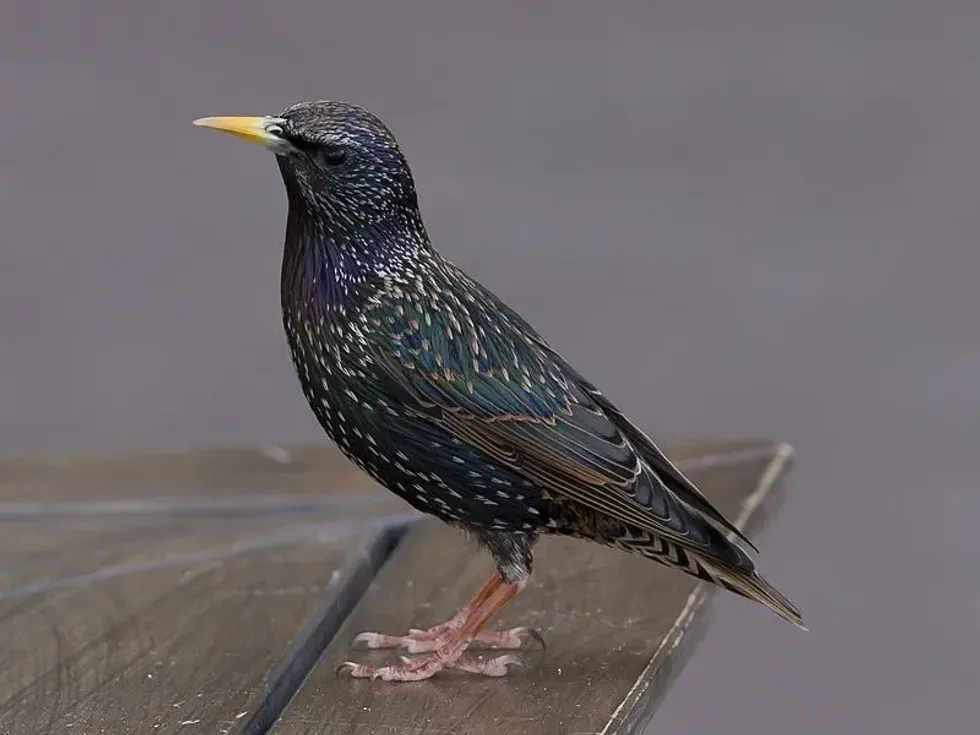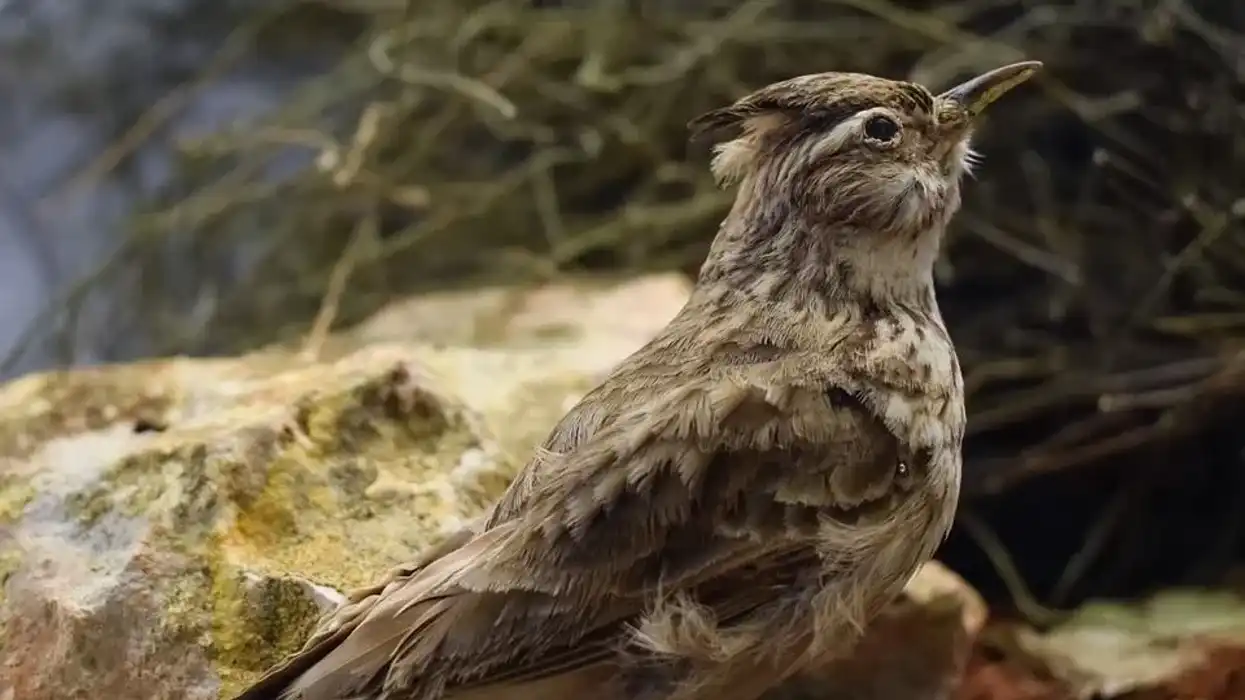European Starlings are also known as the common starling. The European Starling scientific name is Sturnus vulgaris.
It belongs to the order of Passeriformes. The European Starling size is considered to be medium size and has glossed green feathers that cover the back, nape, and breasts.
The black wings are occasionally seen with a veneer green and purple. The legs are reddish or pinkish-brown in color and the iris is dark brown in color.
The feathers of the wings of the male are elongated over the breast. The wingspan of these birds is around 12-17 in (305-432 mm).
The European Starling habitat is mostly lowlands and it is also found in urban areas, buildings, parks, and gardens. The breeding season begins around spring and ends around early summer.
The nest site is explored by both males and females and the nests are built by both the parents. These birds also use some artificial cavities or nests or places of other birds like a woodpecker hole.
European Starling eggs are glossy white-blueish in color and are incubated mostly by females. A juvenile European Starling is helpless at birth.
The European Starling diet includes insects like grasshoppers, crickets, berries, and seeds and the young birds are fed soft animals initially. The European Starling song is quite known for its loud noise and varying varieties and the European Starling bird is also known to mimic other animals and humans.
The European Starling invasive nature is believed to be negative towards the environment and other bird species. It is quite gripping to know about these bird species so read on, and if you're interested, read about the metallic starling and violet-backed starling too.
European Starling Interesting Facts
What type of animal is a European Starling?
These starlings are birds.
What class of animal does a European Starling belong to?
These Starlings belong to the class of Aves of birds.
How many European Starlings are there in the world?
There exist more than 200 million of these starlings ranging from Alaska to Mexico.
Where does a European Starling live?
The European Starling range throughout the Northern Hemisphere is native to the Eurasia continent and is found throughout Europe, North Africa, India, Nepal, the Middle East including Israel, Syria, Iran, Iraq, and north-Western China.
What is a European Starling's habitat?
These starlings prefer lowlands and thus, inhabit non-mountainous terrains. During the breeding season, these birds need to makes their nests in holes and to have vegetation for feeding.
These also inhabit open moorland or salt marshes. It can be easily spotted around people and is also seen in mowed lawns, city streets, and agricultural lawns, trees, buildings that contain cavities, or niches for nesting.
Who do European Starlings live with?
These starlings social birds and are mostly found in flocks of varying sizes.
How long does a European Starling live?
European Starlings are known to live for about 15 years.
How do they reproduce?
Breeding takes place around spring and ends in the early summer. In the northern hemisphere, it starts at the end of March through to the beginning of July, whereas in the southern hemisphere, it begins in September and ends in December.
Endemic starlings in Europe go through three different phases of breeding. The nest is built by both the parents and lined with grass and barks.
The first clutch contains about five eggs, the second or intermediate clutch is due to the polygamous behavior of the bird, and the third clutch occurs 40-50 days after the first clutch. The eggs are glossy and light blue and white in color.
Incubation lasts for about 11 days. Females are responsible for incubating the eggs for the majority of the time.
The chicks are helpless at birth and initially are only fed soft, animal food, and then a wider variety is fed. The European Starling nestling or the young leave the nest after 21-23 days.
What is their conservation status?
The conservation status of these birds is Least Concern.
European Starling Fun Facts
What do European Starlings look like?
These starlings have glossed green feathers or plumage that cover their breasts, back, and nape. The black wings sometimes have a sheen of green and purple.
The tips of the feathers erode away during winters and thus, white or cream-colored flecking appears on a dusky black background, mostly on breasts. These feathers are rounded at the base and jagged at the tip.
The leg is reddish-brown in color and the iris is dark brown in color.
Seasonal changes in the bill color happen which is yellow during breeding season or mating season and black otherwise. Males have longer-shaped feathers covering the breast while the females have short plumage.
Males have a blueish spot at the base of their beaks or the bill while females have reddish-pink speck. Juveniles do not have the noticeable gloss, they have rounder tips to their wings and instead of the yellow bills, they have brownish-black bills all year.

How cute are they?
Some people consider these starlings cute because of their size and appearance.
How do they communicate?
These birds are known to be highly vocal and are only silent when they are molting. The males are known to make creaking, warbling, clicking, gurgling, and chirrup sounds.
These European Starlings, in general, also do whistling and chattering, and can make harsh trills, smooth liquid sounds, and rattles. These birds are also known to be mimics and often copy the sounds of other birds and animals like frogs. These include the sounds of meadowlarks, jays, and hawks.
The European Starling call consists of varying sounds when attacking intruders, or warning calls. The songs of this bird tend to consist of loud whistles or soft, jumbled warbling.
How big is a European Starling?
These songbirds are of medium size. The weight of this bird ranges from 0.13-0.22 lb (0.06-0.1 kg) and their length is around 8.7 in (220 mm).
How fast can a European Starling fly?
These Starlings are strong fliers and reach a speed of up to 48 mph (77.2 kph). The wingspan of these birds is around 12-17 in (305-432 mm).
How much does a European Starling weigh?
These Starlings can weigh around 0.13-0.22 lb (0.06-0.1 kg).
What are their male and female names of the species?
There are no specific names for the males and females of this species.
What would you call a baby European Starling?
A baby or young European Starling has no particular name but the young ones of birds are in general called chicks.
What do they eat?
This bird species is an omnivore and preys on insects found in the ground or soil by widening its beaks or the bill. The food includes seeds, insects, vertebrates, invertebrates, plants, and fruits.
This includes centipedes, spiders, moths, and earthworms. Popular plant foods in their diet include berries, seeds, apples, plums, pears, and cherries. Young birds are fed softer animals initially.
Are they aggressive?
The European Starlings are very aggressive towards other birds and occasionally toward humans.
Would they make a good pet?
These European Starlings can make good pets, although they are wild birds, it is easy to tame and keep a European Starling pet. These birds bond closely with their caretakers. These birds can get very affectionate and cuddly with their owners. They are smart, curious, and interactive. As pets, they are fed according to their basal metabolic rate.
Did you know...
These starlings have strong jaw muscles that let them open their beaks when poked or probing into the soil so that they can hunt and grab insects, even after the first frost. Starlings also have an extra receptor that helps them see ultraviolet light.
The population of many native species of birds is declining due to the aggressive nature of starlings. They are also known as nest bullies.
The European Starlings are commonly seen in urban areas and readily visits bird feeders. Some of these birds are also spotted in or around golf courses and parking lots.
The European Starling nest is made of feathers, fine barks, leaves, and grass. Many or large numbers of European Starlings often come together or congregate before dusk near the roosting areas to sing, preen their plumage, and rest in groups or flocks.
The groups or flocks of European Starlings are known as a constellation, filth, scourge of starlings.
European Starling predators include hawks, falcons, raccoons, rats, and owls.
Why is the European Starling a problem?
These European Starlings are a problem because of certain reasons. Firstly, these starlings are known to damage crops and berries.
They are known to feed on crops when not eating pests. Secondly, these birds are aggressive and known to wipe out other native birds and species.
Thirdly, these birds are known to enter buildings and parking lots to roost and build nests that lead to sanitization problems.
It is also believed that these birds can carry transmissible diseases, which can be transmissible to livestock and humans like salmonella, Transmissible Gastroenteritis- a disease of swine, and blastomycosis. That said, no matter how much trouble you have with the European Starling invasive species, they are protected birds and should not be killed.
How did the European Starling get to America?
The European Starling origin in America happened because of the hundred birds that were set loose in Central Park in New York City in the 1890s. These birds were intentionally released by a group who believed that America should have all the birds mentioned by Shakespeare.
Here at Kidadl, we have carefully created lots of interesting family-friendly animal facts for everyone to discover! Learn more about some other birds including the myna bird, or Northern Harrier.
You can even occupy yourself at home by drawing one on our Starling coloring pages.










